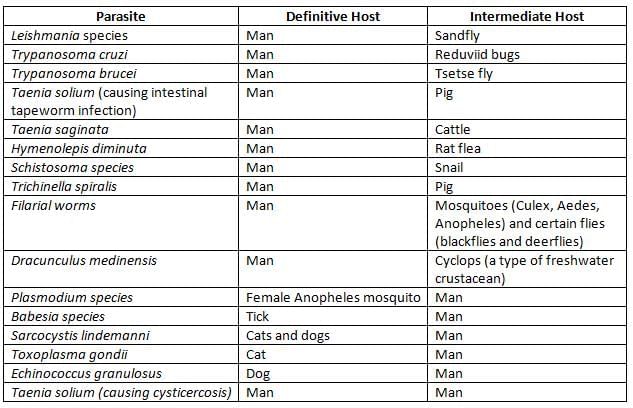NEET PG Exam > NEET PG Notes > Microbiology > Chapter Notes: General Parasitology
General Parasitology Chapter Notes | Microbiology - NEET PG PDF Download
| Table of contents |

|
| Introduction |

|
| Parasites may be Classified as |

|
| Unusual/Rare Mode of Transmission |

|
| Tropical Parasitic Diseases |

|
Introduction
A parasite is an organism that depends on another organism, called the host, for nutrients. This relationship is harmful to the host as the parasite does not provide any benefits in return.
Parasites may be Classified as
- Ectoparasite: These parasites live on the surface of the host's body without penetrating its tissues. Examples include fleas and ticks. When ectoparasites are present, it is referred to as infestation.
- Endoparasite: Endoparasites reside within the body of the host. The presence of an endoparasite is called infection.
- Obligate parasite: These parasites must live as parasites and cannot survive without a host. An example is Plasmodium spp.
- Facultative parasite: Facultative parasites can live either as parasites or independently. Acanthamoeba is an example.
- Accidental parasite: Accidental parasites infect unusual hosts. For instance, Echinococcus granulosus can affect humans.
- Aberrant parasiteor wandering parasite: These parasites cannot develop further when they infect an unusual host. An example is larva migrans, such as Toxocara in humans.
HOST: The organism that provides nourishment and shelter for the parasite.
- Definitive host: The host where the sexual cycle of the parasite occurs.
- Intermediate host: The host where the asexual cycle of the parasite occurs.
- Reservoir host: A source of infection for other susceptible hosts.
- Paratenic host: Acts as a transport host for the parasite, where the parasite lives but cannot develop further. This host is not essential for the parasite's life cycle. An example is the freshwater prawn for Angiostrongylus cantonensis.
Direct/Simple life cycle: Parasites that require only one host, which can be any suitable organism, including humans.
Protozoa
- Entamoeba histolytica
- Free-living ameba
- Giardia lamblia
- Trichomonas vaginalis
- Balantidium coli
- Cryptosporidium parvum
- Cyclospora cayetanensis
- Isospora belli
- Microsporidia
Helminths
- Cestodes: Hymenolepis nana
- Nematodes:
- Ascaris lumbricoides
- Hookworm
- Enterobius vermicularis
- Trichuris trichiura
- Strongyloides spp.
Indirect/Complex life cycle: Parasites requiring one definitive host and one intermediate host

Indirect/Complex Life Cycle with Two Intermediate Hosts

Unusual/Rare Mode of Transmission
- Parasites transmitted through sexual contact: These include Trichomonas, Entamoeba, Giardia, and Enterobius.
- Parasites transmitted via the transplacental or perinatal route: This mode of transmission includes Plasmodium, Toxoplasma, and Trypanosoma.
- Parasites spread through blood transfusion: Such parasites include Plasmodium, Babesia, Toxoplasma, Leishmania, and Trypanosoma.
- Parasites entering through the conjunctiva: An example of this is Acanthamoeba spp.
Tropical Parasitic Diseases
- Food and Waterborne Diseases: These include conditions such as Giardiasis and Amoebiasis.
- Soil-transmitted Diseases: This category includes parasites like Ancylostoma duodenale, Ancylostoma braziliense, and Ancylostoma caninum.
- Vector-borne Diseases: This includes diseases caused by Plasmodium spp., Leishmania donovani, Wuchereria bancrofti, Brugia malayi, Onchocerca volvulus, Trypanosoma brucei, and Trypanosoma cruzi.
The document General Parasitology Chapter Notes | Microbiology - NEET PG is a part of the NEET PG Course Microbiology.
All you need of NEET PG at this link: NEET PG
|
75 docs|5 tests
|
FAQs on General Parasitology Chapter Notes - Microbiology - NEET PG
| 1. What are the characteristics of parasites with a direct or simple life cycle? |  |
Ans. Parasites with a direct or simple life cycle require only one host to complete their development and reproduction. These parasites typically infect their host directly and can reproduce within the same host without the need for intermediate hosts. The life cycle is often straightforward, involving stages such as eggs, larvae, and adults, all occurring within the same organism.
| 2. Can you provide examples of parasites that follow a direct life cycle? |  |
Ans. Some common examples of parasites with a direct life cycle include Enterobius vermicularis (pinworm) and Ascaris lumbricoides (roundworm). Both of these parasites infect humans directly, with their life cycles involving the ingestion of eggs, which then hatch and develop into adults within the human intestines.
| 3. How do direct life cycle parasites differ from those with complex life cycles? |  |
Ans. Direct life cycle parasites require only one host to complete their life cycle, while complex life cycle parasites involve multiple hosts, often with different developmental stages occurring in each. Complex life cycles may include intermediate hosts where larval stages develop before reaching the definitive host, where adult stages reproduce. This distinction affects transmission dynamics and host interactions.
| 4. What are the implications of direct life cycle parasites on public health? |  |
Ans. Direct life cycle parasites often have a more straightforward transmission route, making them easier to control through sanitation and hygiene practices. However, they can lead to high infection rates in populations, particularly in areas with poor sanitation. Understanding their life cycle is crucial for developing effective control measures, including education on personal hygiene and environmental management.
| 5. How can individuals reduce the risk of infection from direct life cycle parasites? |  |
Ans. Individuals can reduce the risk of infection from direct life cycle parasites by practicing good hygiene, such as regular handwashing, particularly before meals and after using the restroom. Cooking food thoroughly, avoiding contaminated water, and maintaining clean living conditions also help minimize exposure to these parasites. Additionally, educating communities about transmission routes is vital for prevention strategies.
Related Searches














